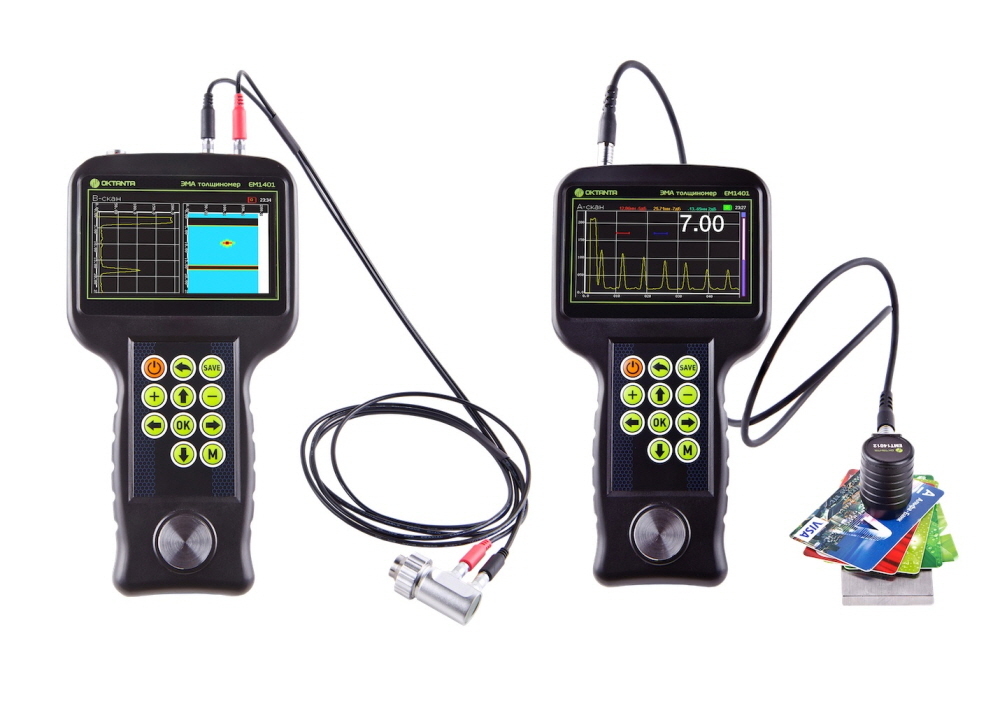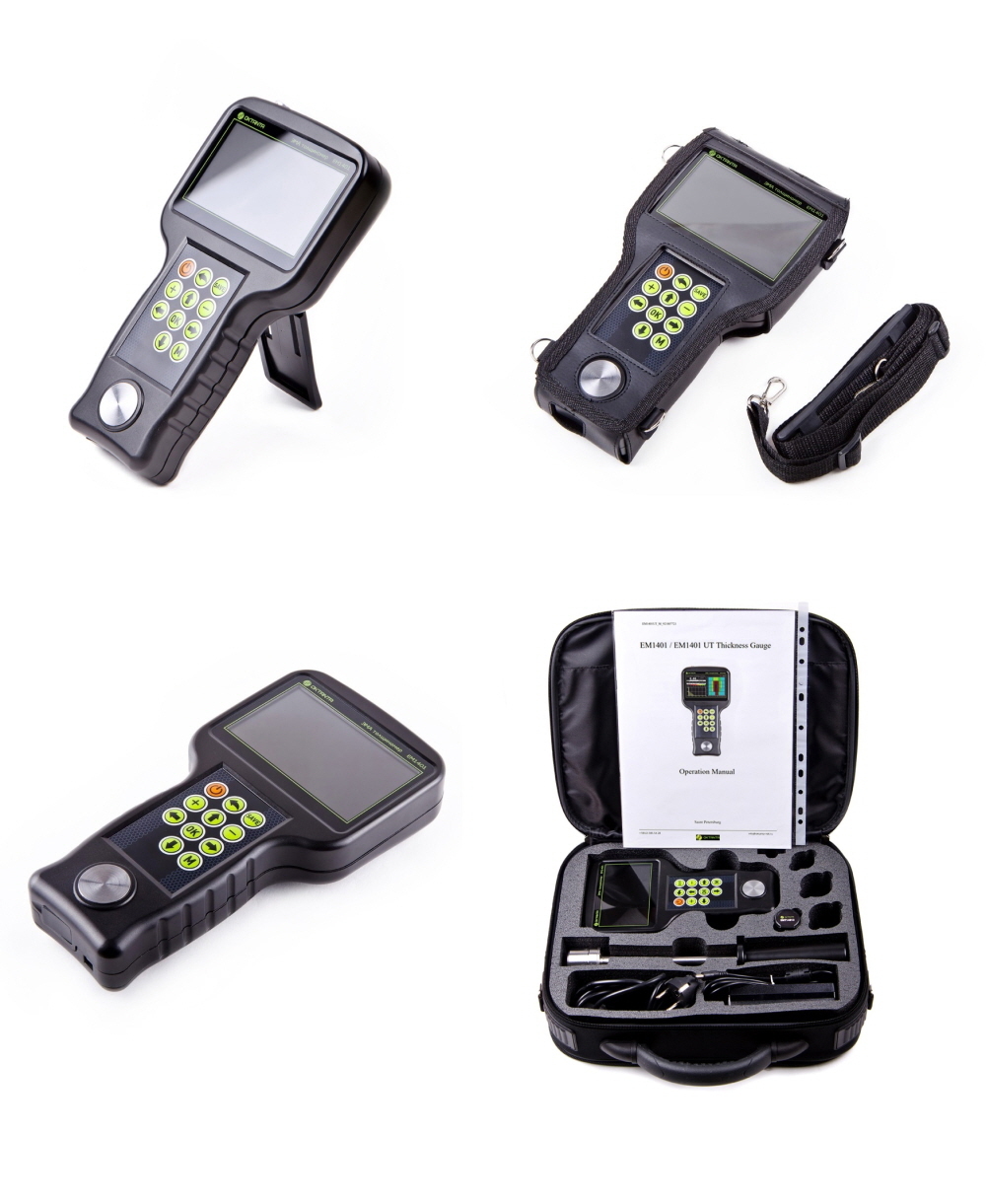|
https://oktanta-ndt.ru/en/contacts-eng/
EMA(Electromagnetic-acoustic)Thickness Gauge
MODEL : EM 1401 UT

특 징 : 커플런트 필요 없고, 페인트 등 코팅 제거 필요 없고, 녹 등 이 물질 제거 필요 없고, 옵션으로 750℃까지 고온에서도 측정 가능함.
설명 : EM1401 EMA 두께 측정기는 센서와 측정물 사이 간격이 최대 6mm까지 측정이 가 능 합니다. 강철 파이프, 압연강재, 봉 및 강철, 알루미늄 및 다른 금속의 두께 측정 을 수행하기 위해 사용됩니다. 코팅 (페인트, 도료, 니스, 에나멜, 플라스틱 등), 녹, 먼지, 염류 퇴적물 등 제거 없이 측정이 가능 합니다. 또한 커플런트를 바르지 않고 도 측정이 가능 합니다.
EMT14014T 특수 센서로 EM1401은 750°C까지 물체의 두께 측정에 사용할 수 있습 니다. 이 장치는 온도에 따라 금속의 음속 변화를 고려하는 특수 알고리즘을 구현 합니다.
EMAT와 PET(초음파 방식)의 두 개의 독립적인 측정 채널을 통해 검사의 신뢰성을 높일 수 있다. EMAT 방식을 사용하지 못하는 재질은 PET(초음파 방식)를 사용하는 것이 좋습니다. EM1401 두께 측정기는 충격 방지 유리로 보호 되며, 컬러 디스플레이를 갖추고 있습니다. EM1401은 데이터 처리 특수 알고리즘을 사용하여 금속의 이방성, 다중 반사체의 존재, 외부 간섭의 존재와 같은 방해 요인이 있는 경우 자동 모드에서 두 께를 정확하게 측정할 수 있습니다. 자동 두께 측정 모드 외에도 첫 번째 에코 신 호와 두 에코 신호 간의 차이로 수동 측정 모드를 사용 할 수 있습니다. 심하게 부 식된 물체에는 수동 모드를 권장합니다.
Description The EM1401 EMA thickness gauge is designed for thickness measurement on steel pipes, sheet metal, rods, and other products made from steel, aluminum and other metals. The device can be connected to the EMAT with the operating clearance of up to 6 mm between the sensor and metal. The clearance can consist of dirt, layer of rust, layer of salt deposits or other non-conductive coating (paint, varnish, enamel, plastic, etc.). The device can connect to conventional PETs. Also, the device can measure the thickness of coatings on magnetic and non-magnetic metals.
The EM1401 UT thickness gauge can connect to the EMT14014T high-temperature sensor that provides thickness measurement on hot objects heated up to 750 °C. The device implements a special algorithm that accounts for changes in the rate of sound propagation in metal induced by temperature. Two independent EMAT and PET measuring channels provide an increase in reliability of tests. PET is recommended on the objects where the thickness of deposits existing on the metal surface prevents the use of EMAT and surface cleaning is required. The EM1401 UT thickness gauge has a color display protected by shock-resistant glass. Like any other EMA thickness gauge produced by our company, the EM1401 UT thickness gauge uses a special data processing algorithm that provides automated correct thickness measurements in the presence of disturbing factors such as metal anisotropy, usage of several reflectors, exposure to external interference. In addition to the automatic mode of thickness measurement, the device allows using manual measurement modes based on the first echo and difference between any two echoes. Manual mode is recommended for severely corroded objects. The EM1401 electromagnetic acoustic thickness gauge allows the user to analyze A-scans, visualize B-scans (three display options), and save data conveniently on C-scans in a matrix form. If necessary, the user can work with strobes, select a thickness measurement mode, signal processing parameters, etc.
Technical specifications of the EM1401 UT thickness gauge: Range of operating ambient temperature : -20…+50 °С Duration of continuous work without recharge of the battery : 7 hours Range of sound velocity setting : 1,000…20,000 m/s with 1 m/s step Highest number of measurements per second 16 Dimensions : 232 x 135 x 44 mm For EMAT Range of measured thickness for steel : 2 mm-80 mm Range of measured thickness for steel without clearance : 2 mm-200 mm Thickness measurement error : 0.08 mm
Permissible clearance between the sensor and tested object with the EMT14012 transducer : Up to 4 mm Permissible clearance between the sensor and tested object with The EMT14013 transducer : Up to 6 mm Permissible sensor skew relative to the tested object surface normal : ±25° Lowest permissible radius of curvature of the tested object surface : ≥10 mm Operating frequency of the device : 4 MHz Range of operating temperature on the tested object surface : -20…+80 °C (-20 …+750 °C where the EMT14014T transducer is used) For PET Range of measured thickness for steel : 0.5 mm-300 mm Range of measured thickness for steel without clearance : 2 mm-200 mm Thickness measurement error : 0.08 mm Lowest permissible radius of curvature of the tested object surface : 25 mm Operating frequency of the device : 5 MHz, 10 MHz
Range of operating temperature on the tested object surface : -10…+60 °C


|